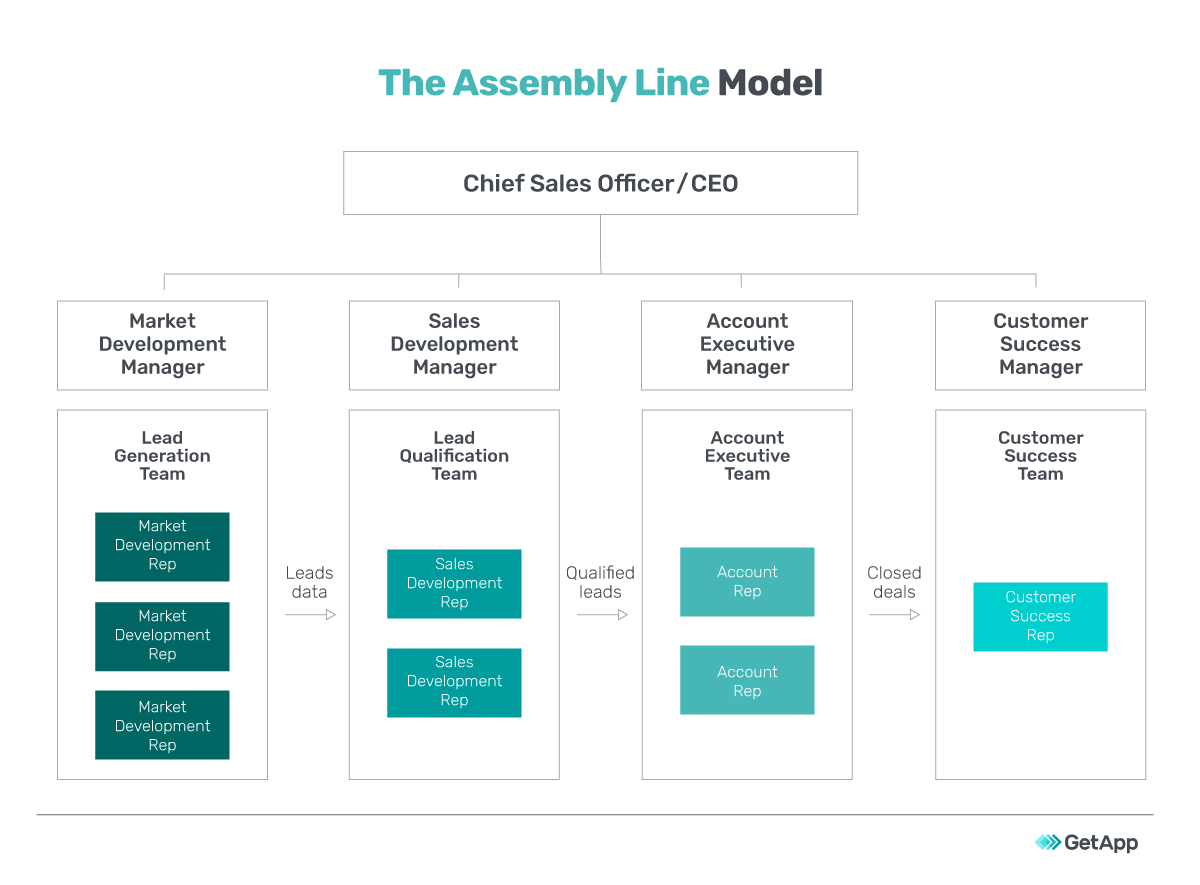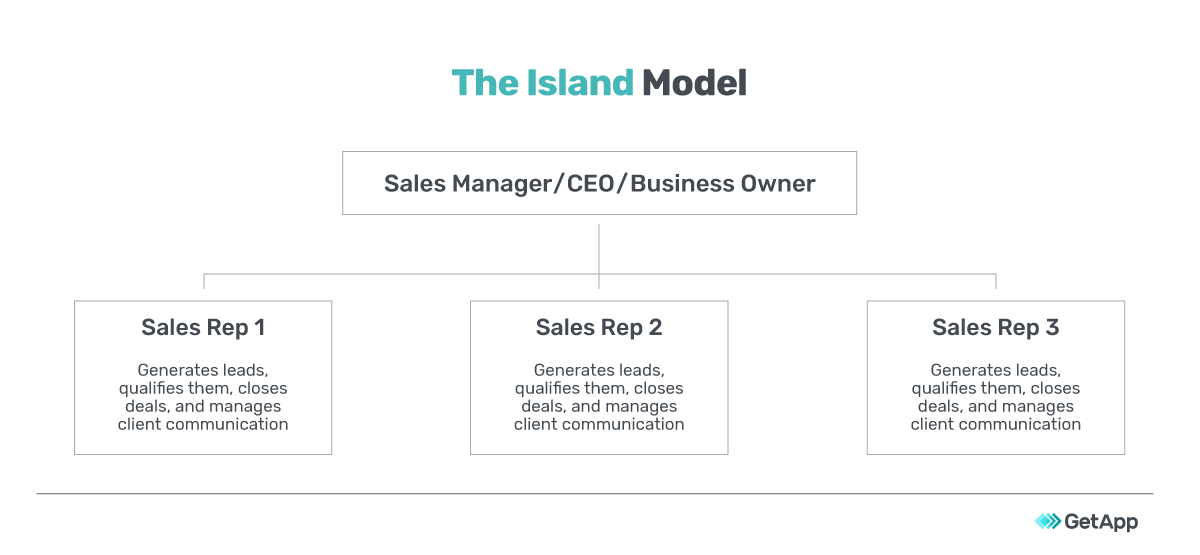Sales Team Management: A Guide to Bringing Out the Best in Your Sales Team
Do you find that certain parts of your role as a sales manager come more naturally than others?
Maybe your analytic mind loves nothing more than nerding out over KPIs. Maybe, as someone who is hyper-organized, you take to sales planning like a duck to water.
As a sales manager, your role is multi-faceted and much more complicated than it used to be. Back in the day, sales managers used to manage the sales force. But now the job also requires planning, strategy, analyzing, and reporting.
Today, however, we’re going back to basics and focusing on sales team management.
What is sales team management?
Sales team management is simply how you manage your sales team. This involves:
- Recruiting
- Hiring
- Onboarding
- Training
- Coaching
- Mentoring
What we’ve not mentioned in the list above are the less obvious, but even more difficult tasks like delivering bad news, managing conflicts, and in some cases, disciplining and even firing members of your team.
In addition to these hard skills are the soft skills needed to be a successful leader:
- Emotional intelligence
- The ability to communicate effectively
- Problem-solving
- Delegation
- Openness
- Patience
- Dedication
- Assertiveness
- Diplomacy
Does that seem like an overwhelming list? Do you read it and think, “I can’t be all those things?”
Don’t worry. You’re not the first person to admit that managing a sales team is a colossal challenge –and you definitely won’t be the last!
The good news is that it may be challenging, but it’s by no means impossible. In fact, with the right tools and the right mindset, becoming a better sales team manager is well within your grasp.
Why is sales team management important?
As competition has increased, so has the importance of sales team management. How well you manage your team has the potential to drive your company forward.
In an industry where an average of 57% of sellers miss their sales quotas, you’re under immense pressure when it comes to ensuring that your sales team achieves its goals.
A team management misstep from you at any stage of the process can spell big trouble. It can:
- Prevent you from meeting your targets
- Affect the morale within your team
- Cost you substantial amounts of money
How one mistake can break the bank
Let’s use hiring as an example.
Did you know that the average annual turnover rate for sales teams is 35%? And that replacing just one employee can set a company back one-half to two times the employee's annual salary?
That may seem like an inflated figure but when you weigh up what it costs to advertise the job, recruit, interview, carry out background checks, onboard, and even provide ongoing training for an employee, it’s easy to see how the numbers add up.
And easy to see why hiring the right people is so important. But your job doesn’t end at hiring the right people. After they’re hired, they need to be:
- Coached
- Motivated
- Supported
- Incentified
- Trained
- Invested in
This is why you can’t sit back and relax after you’ve hired a stellar team!
Because if you as a manager are struggling to retain team members, the problem might not necessarily be with your hiring. Realistically, you could have hit a roadblock anywhere along the journey.
What we’re saying, is that becoming a great sales team manager requires equal attention to every aspect of the job.
Becoming a great sales team manager: where to start?
We’ve already told you that becoming a great manager doesn’t happen overnight and that once you achieve excellence, you need to work tirelessly to stay that way. In this section, we’ll focus on three key areas that will serve as a foundation for your sales team management journey.
1. Give yourself an attitude adjustment
It’s critical to cultivate a leadership mindset. This will take you from simply being a manager on paper, to acting as a leader in your industry.
It doesn’t matter what skills you have. Going into team management with the wrong attitude will set you up for mediocrity, or even worse, failure.
Adopting a leadership mindset takes training and lots of practice. But changing how you behave, will change your results. This is the premise of the Krauthammer Methodology and the crux of our leadership and management programs.
2. Adhere to a set of best practices
Best practices are a set of guidelines or ideas that represent the most effective and efficient way of doing things in a given business situation. Your best practices will complement your leadership mindset, and allow you to realize your behavioral change in a tangible way.
There are practical best practices that are valuable resources to have in your managerial toolbox:
- Honing your hiring skills
- Choosing the right sales methodology
- Making friends with metrics
- Adhering to a process
- Prioritizing planning
And there are customer-centric best practices, that when combined with the practical best practices above, will take your sales management to the next level:
- Being a coach instead of a boss
- Leading with respect, not fear
- Putting EQ over IQ
- Welcoming change
- Investing in your development
3. Understand your team
If you don’t understand the strengths, weaknesses, and unique attributes of each team member, how can you possibly know where they fit in the team? How will you know how to bring out their best? Getting to know your team is essential.
However, before you focus on understanding the role of each sales rep, you need to understand the makeup of your team as a whole.
Imagine you’re a premiership football manager.
Before you can decide where to position your players and what kind of pre-match coaching you’ll give them, you need to know what style of football you’re playing and what formations you plan to use.
Likewise, understanding how your sales organization is made up will enable you to hire strategically and put your team members in positions where they’ll be able to thrive.
Big picture thinking works in some areas of management, and focusing on the minutiae works better in other areas. Remember that to succeed, both must work hand in hand.
This is an instance where you need to look at the bigger picture before you can focus on the individuals.
What are the 3 types of sales team structures?
There are three main types of team structures:
The Assembly Line
The assembly line structure organizes team members based on their job titles. Much like an actual assembly line, this structure relies on specialized employees in different positions working together to get a job done.
In this case, the assembly line refers to the act of moving buyers through the sales funnel.
Some reps generate and nurture prospects, some help to close sales, and some maintain customer relationships once a sale is closed.

The Island
This organizational structure is the antithesis of the assembly line and can be summed up as, “every rep for himself.”
Instead of placing specialized employees at different points along the journey, the island structure uses generalist employees who take their customers through every stage of the sales process themselves – from generating and qualifying leads to closing sales.
Its simplicity and emphasis on individual success make it a popular structure with smaller sales teams. However, while it’s the most simplistic of the structures, it risks being the least efficient.

The Pod
The pod structure contains elements of both the assembly line and the island.
At a team level, the structure is similar to the assembly line in that each member plays a specific role. However, instead of working as one large team, reps are divided into multiple pods typically segmented by:
- Geography
- Territory
- Product
The pod model serves as an easy way for managers to segment and keep track of their sales team while also allowing for flexibility.

All three structures described above can be effective. How you decide to structure your team largely depends on the following factors:
- The regions you serve
- The number of products or services you provide
- The size of your team
- The size and age of your organization
- Your customer base
- The nature of your industry
For the majority of companies, the assembly line and the pod are the structures most likely to drive business and garner consistent results.
Why the assembly line and the pod are such effective structures
What if every player in the premiership focused solely on scoring goals? No passing, no communicating, no strategic formations, just everyone taking their best chance at knocking that ball into the back of the net.
It wouldn’t happen, would it?
That style of haphazard, selfish football is something you might expect if you were watching a team of five-year-olds, but you’d never see it at a professional level!
The assembly line structure and the pod structure are similar to a game of beautiful football. Teams of individuals with different skills, but one shared goal working together – strategically, creatively, and collaboratively, to win.
Both sales team models have the following benefits:
- Help streamline the chain of command
- Help hold reps accountable for the results they’re responsible for
- Maximize efficiency
- Move customers through the sales process quickly
- Allow each rep to deepen their level of expertise
Now that we’ve explored the three types of sales structures, and the two most likely to work within your organization, let’s get to know the individuals in your team.
Who are the members of your sales team?
As we mentioned earlier, big picture thinking has its place, but Premiership football coaches don’t finish top of the table by focusing on the big picture. They get results by focusing on the smaller details.
A football squad consists of around twenty-two players – forwards, midfielders, defenders, and goalkeepers.
Each of these players has a specific role in their team. They’re playing in different parts of the pitch and contribute to the match in very different, yet equally valuable ways. It may be one player’s job to set up a goal, and the other’s to score. But both are necessary to win. Not to mention the keeper. His role in saving or not saving goals can be a literal game changer!
Your sales team should be set up in a very similar way if your team structure follows that of the assembly line or the pod.
Business development reps (BDRs)
Business development reps, or BDRs as they’re known in the industry, are the team members working in the very first stage of the customer’s sales journey.
As the lead generators in the team, they’re responsible for:
- Researching potential prospects
- Gathering information around their needs and pain points
- Organizing the relevant data so the lead can be pre-qualified
Sales development reps (SDRs)
Once leads have been generated and pre-qualified by the BDRs, they’re passed through the funnel to the sales development reps, also known as SDRs.
SDRs are nurturers and the team members who are responsible for qualifying leads. They don’t just focus on qualifying the leads generated by the BDRs, but inbound marketing leads as well. These are prospects that reach out to your organization organically. The ones that ‘make the first move’!
An SDR’s role entails:
- Determining if the prospect fit the desired customer profile by
- Reaching out to them and asking the right questions
- Carrying out further research
- Forwarding the qualified leads to the accounts team
Account executives
Account executives are the closers and they mean business. They take the baton from the SDRs and take it across the finish line by:
- Demonstrating products
- Responding to prospects’ questions
- Overcoming objections
- Doing anything else necessary to close the deal
The reps you want in this position are the ones who have a unique ability to see things through the end.
Customer success reps
Once a sale has been closed, the customer needs to be settled into their new product or service. This is where the customer success reps come in.
Their role is to:
- Keep the customers happy
- Educate customers on the value their purchase provides
- Explore new opportunities to deepen the relationship
When a customer success rep does their job properly it results in improved customer retention and an increase in upsells or referrals.
How to bring out the best in your entire sales team
Earlier on, we spoke about both the practical and people-centric best practices that will help you become a great sales team manager.
But there are additional ways to bring out the best in your sales team. The less you can leave to chance, the better. This is why you should work on your team member’s strengths and then segment with success in mind.
Train to your team members’ strengths
An important part of your job as a sales manager is to devise a long-term growth and development plan for your team. Companies that invest in formal, ongoing training processes can yield up to 50% higher net sales per sales rep.
But remember that truly effective training isn’t one-size-fits-all. And why would it be? After all, your sales team is not a monolith. That’s why it’s crucial that when it comes to training your sales team, you work to their strengths.
Focusing on their strengths instead of their weaknesses is:
- A better use of your time
- More likely to inspire and motivate your sales reps
Let’s jump back into the head of our Premiership football coach. If one of his players is known for his speed and agility but not so great at defending, what will his approach as a coach be? To focus all his energy on training this player to be a better defender? Of course not.
When it comes to his development, he’ll play to his strengths, meaning he’ll:
- Help him take his fitness and stamina to the next level
- Work on his penalty-taking
- Do all he can do to turn him into the best forward his team has ever seen
Keep this in mind when you develop the ongoing training plan for your sales force. Some of your team members will be competent closers. Others are natural nurturers. Your job is to identify these strengths, then take what each rep is good at, and make them great at it instead.
Krauthammer offers a variety of training programs that won’t just equip your reps with the tools and skills to do their job well but will bring about the lasting behavioral change they need to truly succeed.
Segment for success
Segmenting, at its core, is simply how you divide elements of your organization. Segmenting in sales can refer to how you divide your sales team, as well as how you divide your customer base. Donald Norman, an American researcher and author said:
“Market segmentation is a natural result of the vast differences among people.”
This quote serves as a good reminder that there’s a difference between treating people equally and treating people as though they are the same.
If you don’t acknowledge and celebrate the differences in your sales team as well as your customer base, then it’s impossible to provide optimized, personalized experiences.
Segmenting your sales team
The assembly line and the pod – two team structures that we mentioned earlier – lend themselves perfectly to sales team segmentation.
Working to your sales reps’ strengths is not limited to training. When you identify their strengths, you can use this information to assign roles and accounts accordingly.
Segmenting your sales team is a great way to give them more opportunities to do what they’re best at. You can hold sales reps accountable by:
- Adapting key metrics to the individual
- Matching their strengths to the needs of the prospect
- Communicating your segmenting strategy to them
Segmenting your customer base
Segmenting your customer base gives your team a better understanding of who you’re targeting, which:
- Enables them to target qualified leads more quickly
- Engage with them more effectively by using strategies specific to the type of customer
How you segment your customer base depends on you, your organization, and your industry, but it’s often based on the following:
- Demographics
- Geography
- Preferences
- Interests
- Needs
- Behavior
- Online activities
- Other shared attributes
From who to how they’re prospected and qualified to how they’re supported and communicated with – think customized content and targeted ad campaigns. We live in a time where 80% of customers expect a personalized brand experience, so stretch customer segmentation across the entire customer journey.
Leading your sales team to success: a recap
With the right leadership mindset, you can be the manager you’ve always wanted to be, but it takes time and dedication along with the steps we’ve outlined in this post. So:
- Adhere to best practices
- Establish your sales team structure
- Get to know your team
- Play to their strengths
- Segment for success
And if you ever get discouraged, just remember: Man United didn’t become a household name with a case full of trophies overnight.

